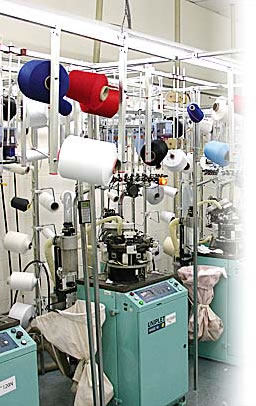 Sock Knitting and Quality
Socks are knitted, giving them stretch and the ability to conform to the foot and leg. Generally, a stockinette or plain knit stitch is used in the foot area and a rib stitch is used in the leg area. The rib stitch is very stretchy, with the ability to return to shape. As both the stockinette and rib stitches are simple knit constructions, the stitch can ravel out if a yarn is broken. Look for evenly knitted stitches on socks and a flat seam at the toe. Toe seams placed high over the toe are usually more comfortable than those at the end of the toe. Both the toe and heel areas should be smooth, otherwise irritation could occur during wear.
A Closer Look at Sock Knitting
Tube socks are circular knits and have no shaped heel area. The socks can be put on several ways and will stretch enough on any side to fit the heel area. Sometimes the tube sock has one seam at the end of the toe. Be certain this is very flat and smooth as it is in a critical area for wearing comfort.
Check also the ribbing at the top of the sock. Socks that keep falling down are annoying. Spandex yarns in the calf area will help prevent this. Generally, the wider the band of ribbing, the better the sock will stay up. Also, a narrow band of stretch yarn (often made of elastic) tends to roll over or curl at the top, causing discomfort to the wearer.
Heel shape in a sock is equally important to comfort. A square heel gives the best fit. A small, curved heel tends to slip under the foot easily and bunch in the shoe.
Another feature of construction to check is the amount of stretch in the sock. Be certain both the body and the ankle areas of the sock will slide over the foot easily. People with high insteps especially need to check this.
Toe and heel reinforcements are important features. Nylon thread is often knitted into these areas to prolong wear. Occasionally, linen yarns are knitted into the toe area for the same purpose. While linen is a strong fiber, it does not equal the durability of nylon reinforcements. In any case, four- or six-ply yarns should be used in these areas. They form thicker yarns which give longer wear. The reinforcement should be wide enough to cover all joints on the toes. This area may be double knit for increased durability. Check for an extra high heel guard or reinforcement above the location where the back of the shoe rubs against the sock. On adult men's socks, this will be 3"–3 1/2" from the bottom of the sock.
Source: A portion of this information appeared in Ohio State University Extension fact sheet: “Textiles and Clothing - Selecting Socks” by Joyce Smith, Ph.D., and Norma Pitts.
Sock Knitting and Quality
Socks are knitted, giving them stretch and the ability to conform to the foot and leg. Generally, a stockinette or plain knit stitch is used in the foot area and a rib stitch is used in the leg area. The rib stitch is very stretchy, with the ability to return to shape. As both the stockinette and rib stitches are simple knit constructions, the stitch can ravel out if a yarn is broken. Look for evenly knitted stitches on socks and a flat seam at the toe. Toe seams placed high over the toe are usually more comfortable than those at the end of the toe. Both the toe and heel areas should be smooth, otherwise irritation could occur during wear.
A Closer Look at Sock Knitting
Tube socks are circular knits and have no shaped heel area. The socks can be put on several ways and will stretch enough on any side to fit the heel area. Sometimes the tube sock has one seam at the end of the toe. Be certain this is very flat and smooth as it is in a critical area for wearing comfort.
Check also the ribbing at the top of the sock. Socks that keep falling down are annoying. Spandex yarns in the calf area will help prevent this. Generally, the wider the band of ribbing, the better the sock will stay up. Also, a narrow band of stretch yarn (often made of elastic) tends to roll over or curl at the top, causing discomfort to the wearer.
Heel shape in a sock is equally important to comfort. A square heel gives the best fit. A small, curved heel tends to slip under the foot easily and bunch in the shoe.
Another feature of construction to check is the amount of stretch in the sock. Be certain both the body and the ankle areas of the sock will slide over the foot easily. People with high insteps especially need to check this.
Toe and heel reinforcements are important features. Nylon thread is often knitted into these areas to prolong wear. Occasionally, linen yarns are knitted into the toe area for the same purpose. While linen is a strong fiber, it does not equal the durability of nylon reinforcements. In any case, four- or six-ply yarns should be used in these areas. They form thicker yarns which give longer wear. The reinforcement should be wide enough to cover all joints on the toes. This area may be double knit for increased durability. Check for an extra high heel guard or reinforcement above the location where the back of the shoe rubs against the sock. On adult men's socks, this will be 3"–3 1/2" from the bottom of the sock.
Source: A portion of this information appeared in Ohio State University Extension fact sheet: “Textiles and Clothing - Selecting Socks” by Joyce Smith, Ph.D., and Norma Pitts.